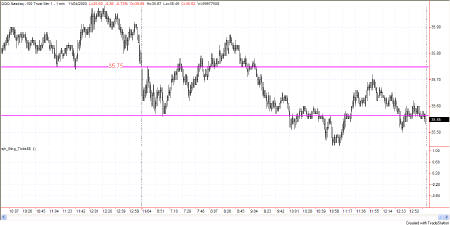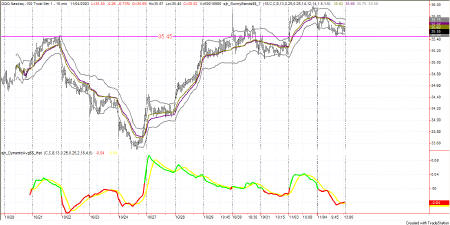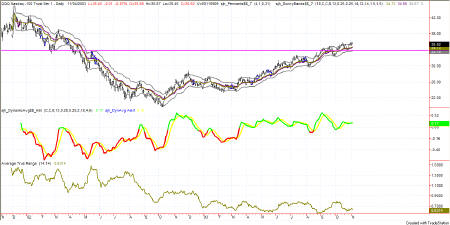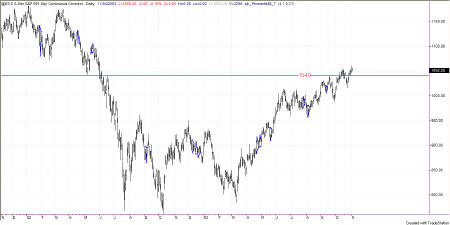
The Sunny Side of the Street
TECHNICAL ANALYSIS EDUCATION: EXPLAINED AND DECIPHERED FOR NEW AND
VETERAN TECHNICAL ANALYSTS ALIKE.
TUESDAY EVENING -
Nov 04, 2003
Archives of Past
Commentaries . How Did We Do?
Weekend Stock Picks --
CLICK HERE
| Anyone interested in posting comments or questions to the bulletin board may click here. Sunny personally answers each question or comment posted. | ||
|
|
Yet another day with TradeStation not working. So, here's my commentary without indicators, using charts from Yahoo Finance. |
$55,989 in Stock Picks to date! Click Here to view.

This morning's low marked the turning points for the day. Today's sideways action continued to record what I have been saying for months. The market continues to move sideways. The reason the Sunny_Bands work so well in these markets is because they are based first on my dynamic moving average, which echos the market's changes as they change over time, and secondly because the outer bands consist of Average True Ranges which show where the markets have been moving lately. And, as I keep saying, the markets tend to go where they tend to go. So, you can expect that it will be a rare event when the prices are out of bounds of the Sunny_Bands. When that rare event happens, like yesterday, you hold onto the profits until price touches back inside the Sunny_Bands, where previous price action has played.
In yesterday's commentary I said I wouldn't be surprised to see the markets dip back down to the Attractors, and that's what they did today. On the chart above you can see clearly that today's low made it right to the 35.45 Attractor which I had drawn. For tomorrow that could produce the typical expected bounce, and that's what I'm guessing. It is more likely technically for price to bounce and retest than it is to drop right through.
On the daily charts, as above, the markets are still about the same. Price is still running nicely in the top half of the band, giving me the long signal.
On the EMini chart immediately above, you can see the Attractor I have drawn at 1040, which is about where I expect price to return in the current retest. On a touch of 1040, I am expecting a bounce and continued movement upward. Over the long-term I am anticipating a continuation of the long-term trendline, but in the near-term I would expect a retest of the 1040 Attractor.
Attractor: a level to which prices seem to be drawn, like a magnet. Usually these are lines of support or resistance from previous highs and lows, but can also be an important level on an indicator, or the edge of a Sunny_Band.
PHW: Potential Hourly Wage. A term coined by Sunny to examine whether trading for a living is really worth it when compared to the minimum wage standard. Before considering a trading system to be a success, it should pass the PHW test.
RSI: Relative Strength Index (TradeStation function)
SDMA: Sunny's Dynamic Moving Average (proprietary)
Shooting Star: A candlestick pattern discussed further under Reference, Candlesticks.
SDMA_Hst: Sunny's Dynamic Moving Average presented in a histogram format where the line representing the difference between the two SDMA lines turns from red to green when the two SDMA lines cross each other (the difference is zero). The yellow line is an average of the histogram line.
Sunny_Band: Sunny's Dynamic Moving Average plus 1.5 ATR and minus 1.5 ATR, creating a band on either side of the SDMA.
Vehicles: Trading symbols. IBM is an equity vehicle; SPU03 is the SP futures contract that expires in Sept of 2003; @ES.D is the EMini; mutual funds are vehicles; gold is a trading vehicle; etc.
This commentary is meant only for EDUCATIONAL PURPOSES. It is to help you see how a Technical Analyst reads the signs in the markets.
Stay sharp and on your toes. Moves can reverse on a dime, anytime. Let the market speak to you. If the market is going down, by golly ignore my commentary from the night before and know that the market is going down.
RULES OF THUMB:
0. I keep the chart in Figure 1a on each day's commentary simply to illustrate how much in tandem the 4 indexes I watch actually are. For this reason, I don't always comment on every index. Analysis of one speaks highly for the same analysis for each of the other indexes.
1. When price is pushing the upper Sunny_Bands upward and then eases off and moves back toward the midline, it's time to take profits. If it starts moving up and pushing on the Sunny_Bands again, it's time to get back in. Likewise, if the market is pushing down on the lower Sunny_Band and eases off to move back to the midline, it's time to take profits from the short play.
2. Divergence of the RSI and price is another good time to take profits and wait for a breakout of price before taking a position.
3. When the exchange puts in curbs or trading halts on a large move down, it usually (not always) stops the downward motion. After the market reopens is a good time to take profits from your short position.
4. The market can't go nowhere forever. Eventually, who knows how long it will be, there will have to be a breakout-- one direction or the other.
5. This commentary is for educational purposes only, and is meant only to teach readers about my indicators, other technical indicators, and how I read them.
==<:>==
While it may be true that a picture is worth a thousand words, it is definitely not true that a picture deserves a thousand words.


